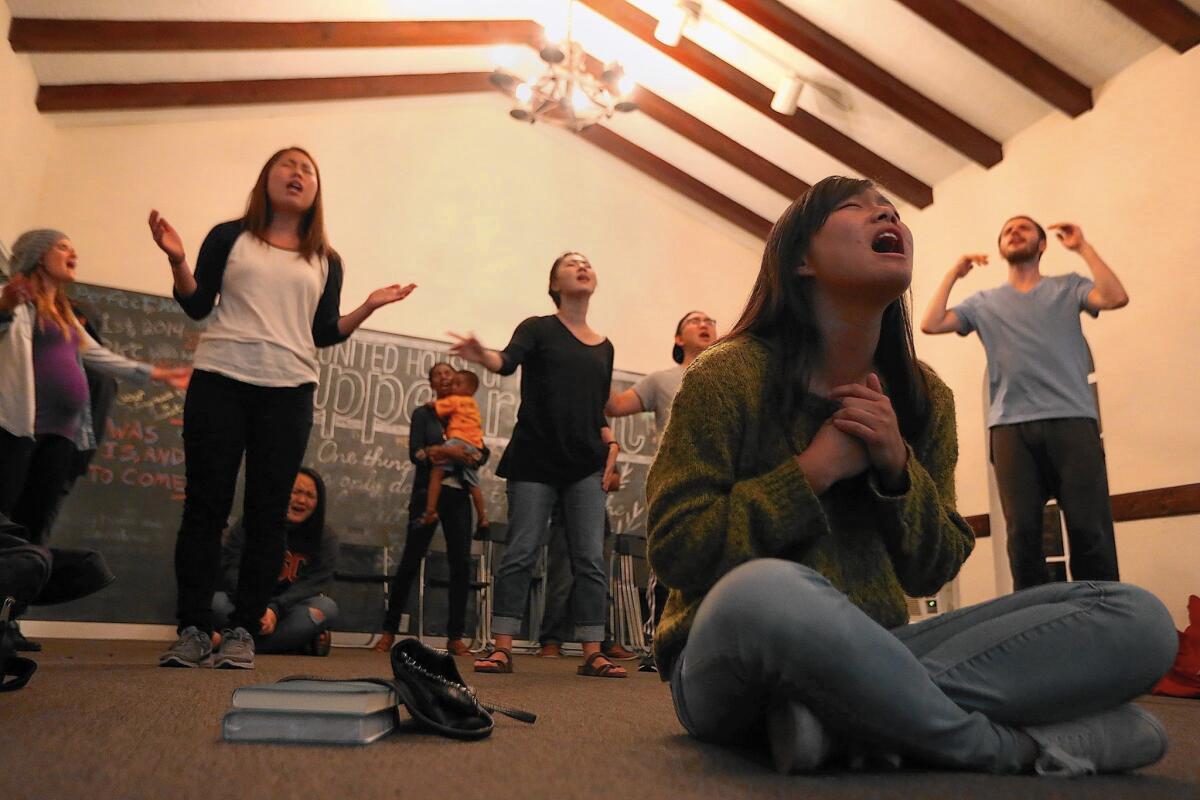USC adds church building to its expanding portfolio

- Share via
USC has expanded its footprint around its main location south of downtown by moving nonacademic programs away from campus, leasing more space downtown and upgrading a shopping center it has owned for years.
But as the campus has steadily grown, one piece of property around the school’s main hub — between Jefferson and Exposition boulevards — has stayed out of the Trojan portfolio: the United University Church on 34th Street near Trousdale Plaza.
USC administrators said they have asked church leaders periodically if they were willing to sell, but the church always declined. But, last year, United University officials began to reconsider their stance. And last month, USC agreed to acquire the church site.
“We’ve been thinking about our future and what we finally decided is, we wanted to be near campus but we didn’t need to be on campus anymore,” said Pastor Frank Wulf.
The church was never listed for sale, but Wulf and others contacted potential buyers to gauge their interest before accepting USC’s bid.
Neither USC nor church members would disclose the price, which will become public if the sale becomes final, possibly later this year.
Wulf declined to discuss the church’s finances in detail, but said “there was definitely a business aspect to the sale.”
The red-brick building, constructed in 1931, has been owned by the Presbyterian and United Methodist congregation for decades, but also hosts several other religious groups as well as some USC administrative offices and programs.
USC has rented space in the church since at least the 1970s and has been the building’s biggest tenant for years. USC’s Thornton School of Music has also leased space there, and the writing program is on the second floor. The faculty senate also had offices there.
“It would be nice to own it, not pay rent,” said Laurie Stone, the university’s associate vice president for real estate and asset management.
It’s unclear what the university would do with the building once the deal becomes final, but USC has recently been trying to find additional space. University programs including media and public relations moved from the main campus to buildings near Exposition Avenue on the east side of the Harbor Freeway.
“What we have been doing is trying to maintain the academic campus for teaching and research,” Stone said.
The school will hold additional classes at the AT&T Center complex near Staples Center next year. USC agreed to lease an additional 30,000 square feet in the buildings at 1150 Olive St. and 1149 Hill St. this year, making USC the complex’s biggest tenant.
As part of the agreement, a USC sign will replace the AT&T logo atop the 32-story building on Olive Street this month.
The school is also in the midst of a $650-million renovation of USC Village, which will include student housing and stores. The project is scheduled to open in 2017.
Wulf said the church and its nearly 90-member congregation would be able to stay in the location for several years before finding a new location. USC officials said all leases would be honored.
And officials say they will preserve the structure. “The university will not tear down the building,” said Varun Soni, USC’s dean of religious life, adding that they would work with student organizations that use the church to find new locations, if necessary.
“Our office is committed to working with all groups to make sure they have the appropriate space,” Soni said.
Still, some current tenants are concerned about the future.
Nearly 800 people have signed an online petition addressed to USC President C.L. Max Nikias and the school’s board of trustees asking them to preserve the building and continue to make sure that religious groups can use it.
“We envision the church building being used as a Christian student center and remaining a community house of worship, in honor of its Christian heritage and roots,” the petition says.
“The campus is the safest place for our students,” said Douglas Matthews, director for the United House of Prayer, a nondenominational student group that uses the church several times a week. “If we had a prayer room located away from campus, the safety of our students would be our biggest concern.”
Villip Gatlin, a board member for the Christian Released Time Education Program, brings students from the nearby 32nd Street USC Performing Arts Magnet to the church for religious study sessions. He said finding a new location close to the elementary campus could be difficult. “It’ll be like we’re starting all over again,” he said.
And some USC students said they would prefer to stay in the church, which has history that other campus buildings lack, they say.
“When you worship and pray in a space, you cultivate a spirit in the room,” said Jordan Johnson, a freshman who attends United House of Prayer meetings. “I feel like there’s something really beautiful happening in that building.”
twitter: @byjsong
More to Read
Sign up for Essential California
The most important California stories and recommendations in your inbox every morning.
You may occasionally receive promotional content from the Los Angeles Times.











